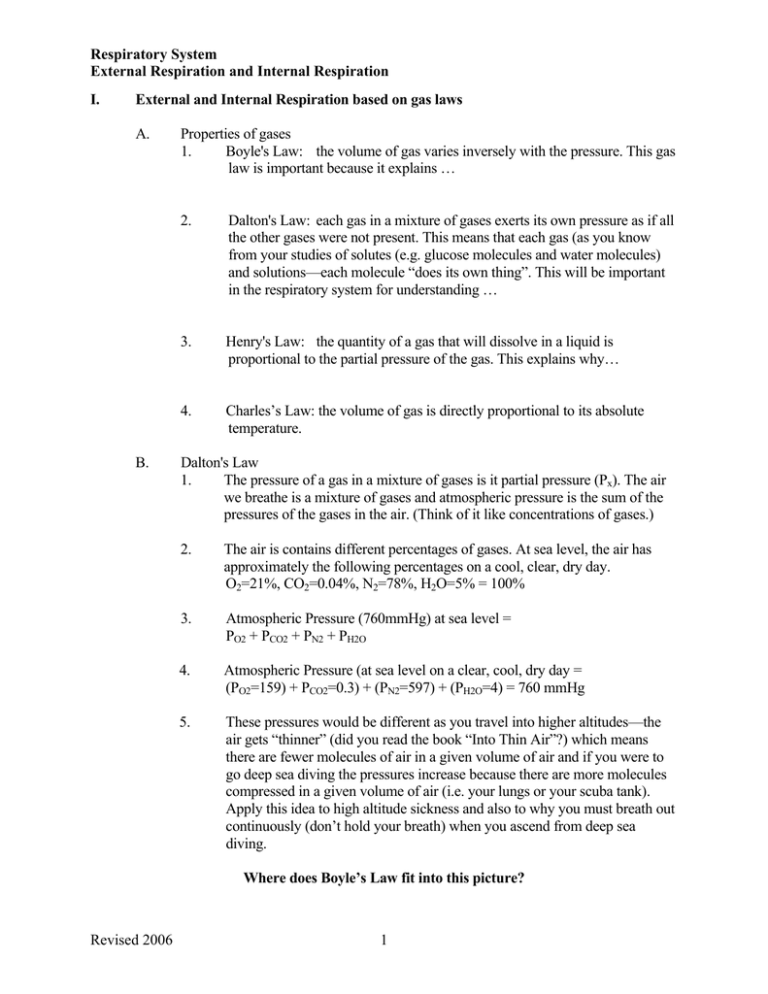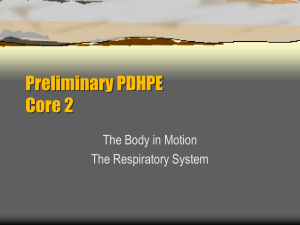Respiratory System External Respiration and Internal Respiration I.
advertisement

Respiratory System External Respiration and Internal Respiration I. External and Internal Respiration based on gas laws A. B. Properties of gases 1. Boyle's Law: the volume of gas varies inversely with the pressure. This gas law is important because it explains … 2. Dalton's Law: each gas in a mixture of gases exerts its own pressure as if all the other gases were not present. This means that each gas (as you know from your studies of solutes (e.g. glucose molecules and water molecules) and solutions—each molecule “does its own thing”. This will be important in the respiratory system for understanding … 3. Henry's Law: the quantity of a gas that will dissolve in a liquid is proportional to the partial pressure of the gas. This explains why… 4. Charles’s Law: the volume of gas is directly proportional to its absolute temperature. Dalton's Law 1. The pressure of a gas in a mixture of gases is it partial pressure (Px). The air we breathe is a mixture of gases and atmospheric pressure is the sum of the pressures of the gases in the air. (Think of it like concentrations of gases.) 2. The air is contains different percentages of gases. At sea level, the air has approximately the following percentages on a cool, clear, dry day. O2=21%, CO2=0.04%, N2=78%, H2O=5% = 100% 3. Atmospheric Pressure (760mmHg) at sea level = PO2 + PCO2 + PN2 + PH2O 4. Atmospheric Pressure (at sea level on a clear, cool, dry day = (PO2=159) + PCO2=0.3) + (PN2=597) + (PH2O=4) = 760 mmHg 5. These pressures would be different as you travel into higher altitudes—the air gets “thinner” (did you read the book “Into Thin Air”?) which means there are fewer molecules of air in a given volume of air and if you were to go deep sea diving the pressures increase because there are more molecules compressed in a given volume of air (i.e. your lungs or your scuba tank). Apply this idea to high altitude sickness and also to why you must breath out continuously (don’t hold your breath) when you ascend from deep sea diving. Where does Boyle’s Law fit into this picture? Revised 2006 1 Respiratory System External Respiration and Internal Respiration 6. Partial pressure is calculated by multiplying the percentage of the mixture the particular gas constitutes by the total pressure of the mixture. PO2 = %O2 x 760 mm Hg PO2 = 21% x 760 mmHg = 159.6 or + 160 mmHg PCO2 = PCO2 = 7. Partial Pressures of Respiratory Gases as they enter and leave the lungs (at sea level) with % concentrations—see supplemental chart. • Note: The partial pressures of gases in your blood are very important in determining the movement of O2 and CO2 between the atmosphere and the lungs (external respiration) and between the blood and the tissues (internal respiration). • Note: A gas diffuses across a membrane from where its partial pressure is greater to where its partial pressure is less. C. Revised 2006 8. Use Dalton’s Law to describe external respiration and internal respiration. Use Fig. 23.18—I’d copy this figure in my notes. a. Look at the partial pressures of gases in the air we breathe, in the alveoli, and in the blood and in the cells. b. Remember: When a gas diffuses across a membrane (respiratory membrane) a gas diffuses from where its partial pressure is greater to where its partial pressure is less (this is nothing new for you). c. Which way is O2 moving at each location? d. Which way is CO2 moving at each location? e. What’s happening to nitrogen? (You’ll see more about this with Henry’s Law). f. Look at the PH2O through the respiratory tree—what’s happening? 9. Know (memorize) normal PO2 and PCO2 values for oxygenated blood and deoxygenated blood. What are normal ABGs (arterial blood gasses)? • Oxygenated PO2 • Deoxygenated PO2 • Oxygenated PCO2 • Deoxygenated PCO2 • Compare these to alveolar air • Compare these to tissue levels Henry’s Law 1. Henry’s law talks about dissolving gases in liquids. Dissolvability depends on the partial pressure of the gas (the pressure and the percentage of that gas in the mixture) and also how dissolvable it is (its solubility). 2 Respiratory System External Respiration and Internal Respiration 2. Nitrogen at sea level pressure is not very dissolvable. Under higher pressures it becomes more dissolvable. CO2 in the air is not very dissolvable, but under pressure (a coke) it dissolves. Take the lid off the coke and what happens? 3. The partial pressures of gases in the air and in your blood are very important in determining the movement of oxygen and carbon dioxide between the atmosphere and the lungs (alveoli) and into the blood (external respiration) and also the movement of oxygen and carbon dioxide between the blood and the cells. 4. Hyperbaric oxygen—how does this work to our benefit (using Henry’s Law)? 5. Describe the “bends” according to Henry’s Law. Explain why the treatment for the bends is to go back down and decompress or quickly transport the patient to a hyperbaric chamber. 6. What is Caisson’s Disease? II. Rate at which alveolar air is renewed by atmospheric air A. Review volumes and capacities from LAB. B. Review conduction zones vs. respiratory zones. C. Functional residual capacity—is gas exchange still occurring? D. Dead air space (conduction zone)—no gas exchange is happening, but as you exhale, the expired air mixes with the air of the “dead space.” As you inspire, the air that reaches your alveoli is mixed with somewhat “old” air. What is the significance of this slow replacement of alveolar air? III. The respiratory membrane (alveolar-capillary membrane). See previous notes and lab studies and remember that although the respiratory membrane is very thin, it still is a “diffusion barrier” through which gases must pass. If that membrane is altered due to increased mucous production, inflammation, or because the thin simple squamous epithelium is replaced with thicker connective tissue (emphysema), then it will be more difficult for gases to pass through the membrane and gas exchange will be hindered. Include Fig. 23.12 below (and/or use diagram from lab manual) Revised 2006 3 Respiratory System External Respiration and Internal Respiration IV. V. Factors that AID alveolar gas exchange—describe each—more space may be needed. A. Relatively thin respiratory membrane (0.004mm thick) results in minimal diffusion distance. B. Partial pressure differential of respiratory gases C. Maximum surface area for gas exchange between alveoli and capillaries D. Capillary structure (simple squamous epithelium and they are narrow—size of diameter of a RBC) E. Solubility of respiratory gases F. Good perfusion of lung tissue Factors that HINDER alveolar gas exchange—describe each—more space may be needed. A. Increase in altitude a. Hypoxic hypoxia b. Altitude sickness c. HAPE (high altitude pulmonary edema) B. Pulmonary disorders that decrease surface area C. Poor perfusion of lung tissue D. Insufficient surfactant and/or increased alveolar surface tension so alveoli can’t open (atelectasis) E. Poor ventilation/poor compliance/restrictive disorders F. Decreased minute volume of respiration (decreased respiratory rate—eg: morphine) Revised 2006 4








